Hide and Seek (Rules and History)
by Simmy Parker
Hide and Seek is a game most if not all of us can remember from our childhoods, and it is a game that we likely passed onto our children.
This classic children's game has been around for centuries and remains a favorite, for the simple reasons that it requires few players, uses neither tools nor props, and facilitates physical activity while piquing the innate hunter curiosity engrained in children as they explore their world and learn survival skills through both communicating, hiding and finding exactly what they are looking for.
Additionally, it is very easy to play, provided the children are in a place with ample and sufficient hiding possibilities. There are not many rules and there is no time limit. This ease of pressure also makes it inviting for children.
Contents
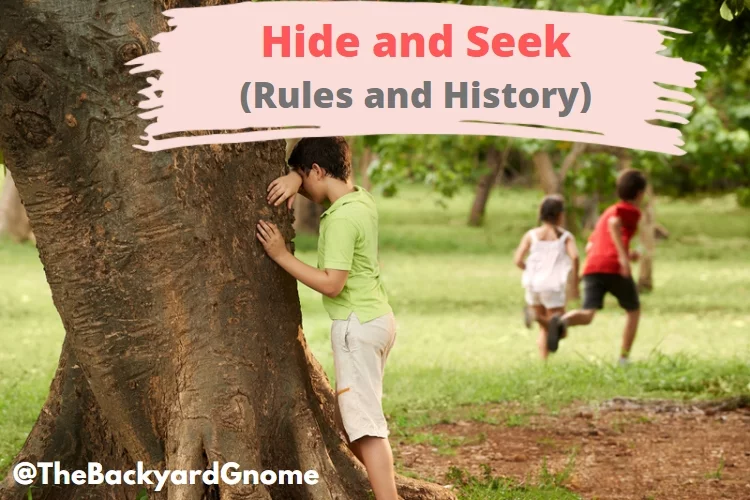
Hide-And-Seek History

The game of hide-and-seek has been around for centuries, and its history is just as fascinating as the game itself. The game is thought to have originated in ancient Greece, where it was known as apodidraskinda. In this version of the game, players would hide in small spaces and then try to find each other.
The game was eventually brought to Rome, where it became known as nascoturma. This version of the game was played with larger groups of people, and it often involved using furniture or other objects to hide.
Hide-and-seek eventually made its way to England, where it became a popular children's game. It wasn't until the 19th century that the game began to be known by its current name.
The game has changed very little over the years, and it remains a popular pastime for children of all ages. Whether you're playing with a group of friends or trying to beat your personal best, hide-and-seek is a great way to have fun and get some exercise.
Hide and Seek Rules

Players: at least two
Rules: There are few rules other than the basic point of the game, which singles out a seeker, known as "it," while the other players find hiding spots. The seeker counts aloud to a number previously agreed upon by all players so they know how much time they have to hide.
This in turn allows them to venture to an appropriate distance and situate themselves before the seeker finishes counting. For example, if playing in a house the seeker may count to 40 or 50 while in a smaller space the seeker may count to 20. The usual speech goes like this: "One, two, three…twenty. Ready or not, here I come!" It is very important to tradition that the seeker say "Here I come" to let the other players know their time is up.
The seeker must close their eyes and often is required to face a wall away from the players. While the seeker counts, the other players look for hiding places and once they are positioned, they cannot move. The seeker finishes counting and the hiding players stay quiet as possible until they are found. They are not allowed to change hiding places once the seeker has finished counting.
Hide and seek is a long favored game as it requires nothing but the players, takes no time at all to set up and makes use of several skills including counting (some seekers may count in intervals: for example, five, ten, fifteen, twenty…ninety-five, 100), the ability to remain silent, base animal instincts like observational skills for hunting or finding a target.
It allows the seeker to tune into their senses to aid them in finding the concealed players, while the concealed players are able to practice remaining calm and silent in what could arguably be described as high-stress situations.
The player found last wins the game and becomes the seeker for the next round. This game is also favored as it gives everyone an equal chance at winning and playing different roles in the game.
Sometimes there is a home base, where the seeker will have counted. If the seeker has not found the players in a certain amount of time, then the hiding players may run to home base before the seeker catches them, and this renders them safe. If a player is tagged while running to home base, they become the next seeker.
This game has been around for centuries as we mentioned. Even in Shakespeare's writings we see references to a child's game of hide and seek. Footraces, tag and the like have been around long as people have had legs. The Encyclopedia of Play in Today's
Society traces this game all the way back to 200 years Before Common Era (200 B.C.). One can feasibly argue the game of hide and seek is as old as survival itself, for it feeds into the very notions and roles of predator and prey, while giving the seeker the thrill of the hunt and the concealed players the thrill of successfully evading a predator.
How to Play Hide and Seek ?

Playing hide and seek is a classic childhood game that can be enjoyed by kids of all ages. The basic premise is simple: one player hides while the others try to find them. But there are many different ways to play the game, so here are some tips on how to make it even more fun.
If you're playing with younger children, it's best to keep the hiding places simple. Just have them hide behind furniture or in closets. For older kids, you can make the game more challenging by having them hide in difficult-to-find places like under beds or in attics.
To make the game even more challenging, you can set a time limit for the person who is hiding. They must stay hidden until the time is up, no matter what. This adds an element of suspense and makes it more difficult for the seeker to find the hider.
The game can also be played with teams. If you have a large group of kids, you can divide them into two teams and have each team take turns hiding and seeking. The first team to find all of the members of the other team wins the game.
Variations of Hide n Seek Game

There are about 23 variations of hide and seek. Here are some popular ones:
1. One person hides while the others look for them. The first person to find the hidden person wins.
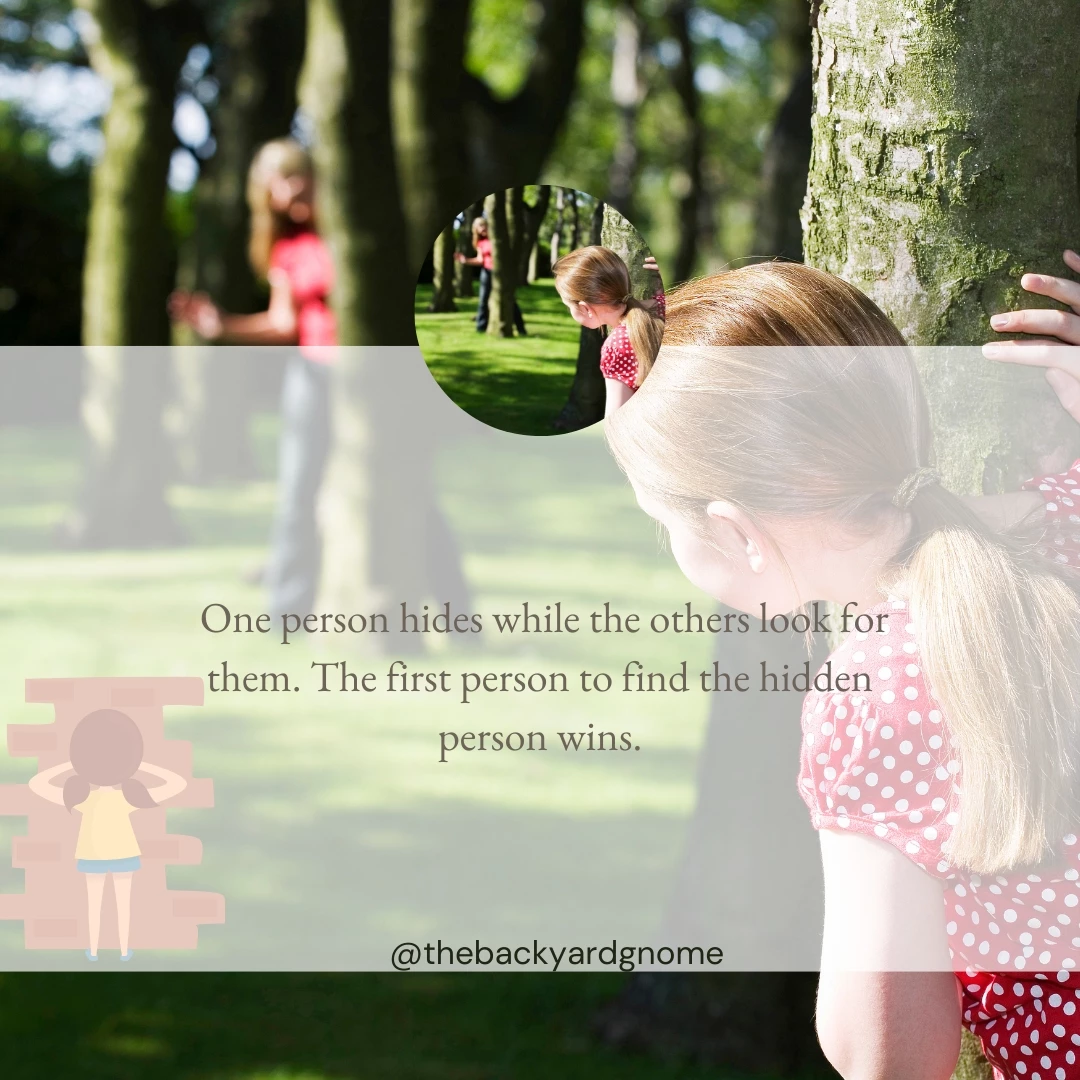
2. One person hides while the others look for them. The person who finds the hidden person gets to be the next hider.
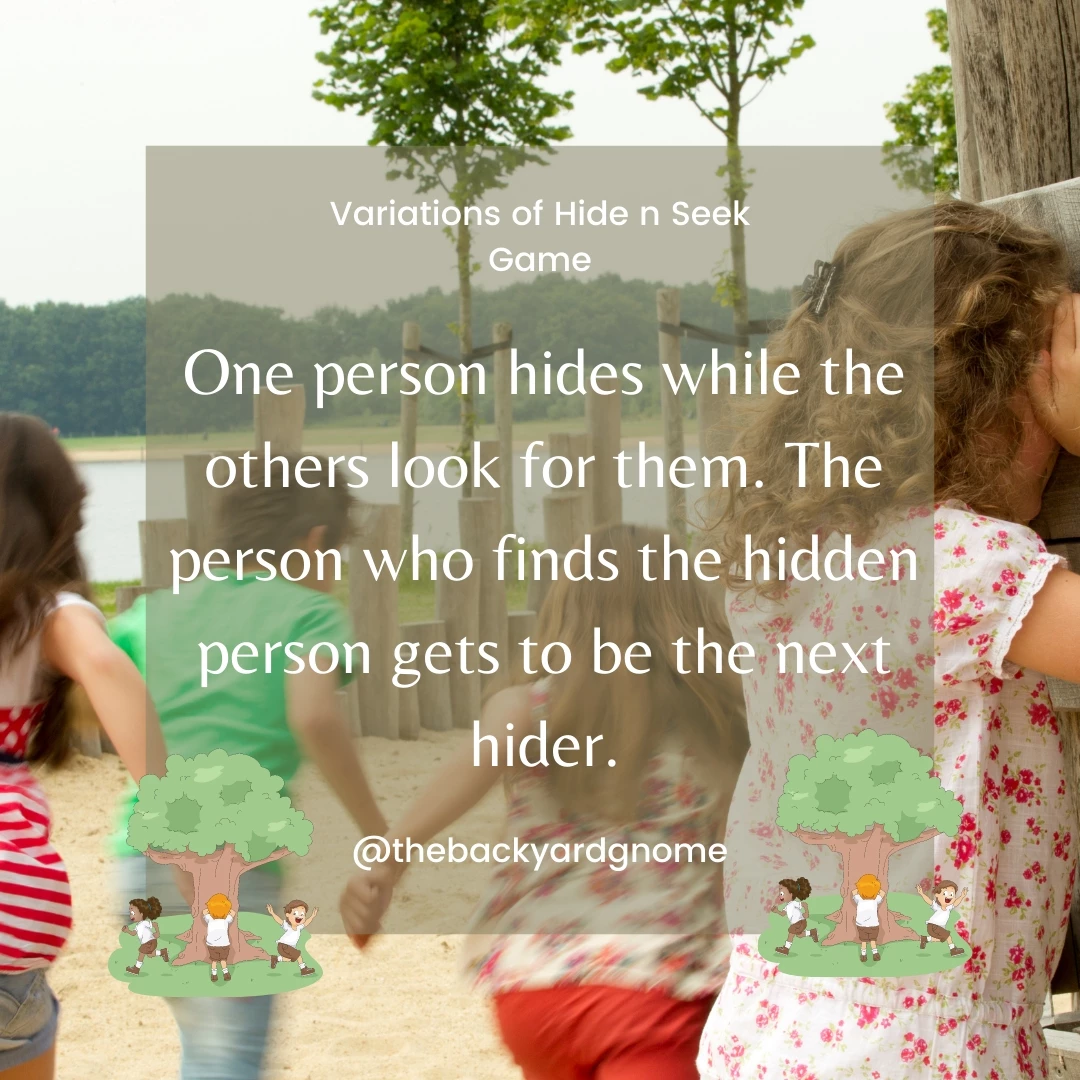
3. One person hides while the others look for them. The last person to find the hidden person is the winner.
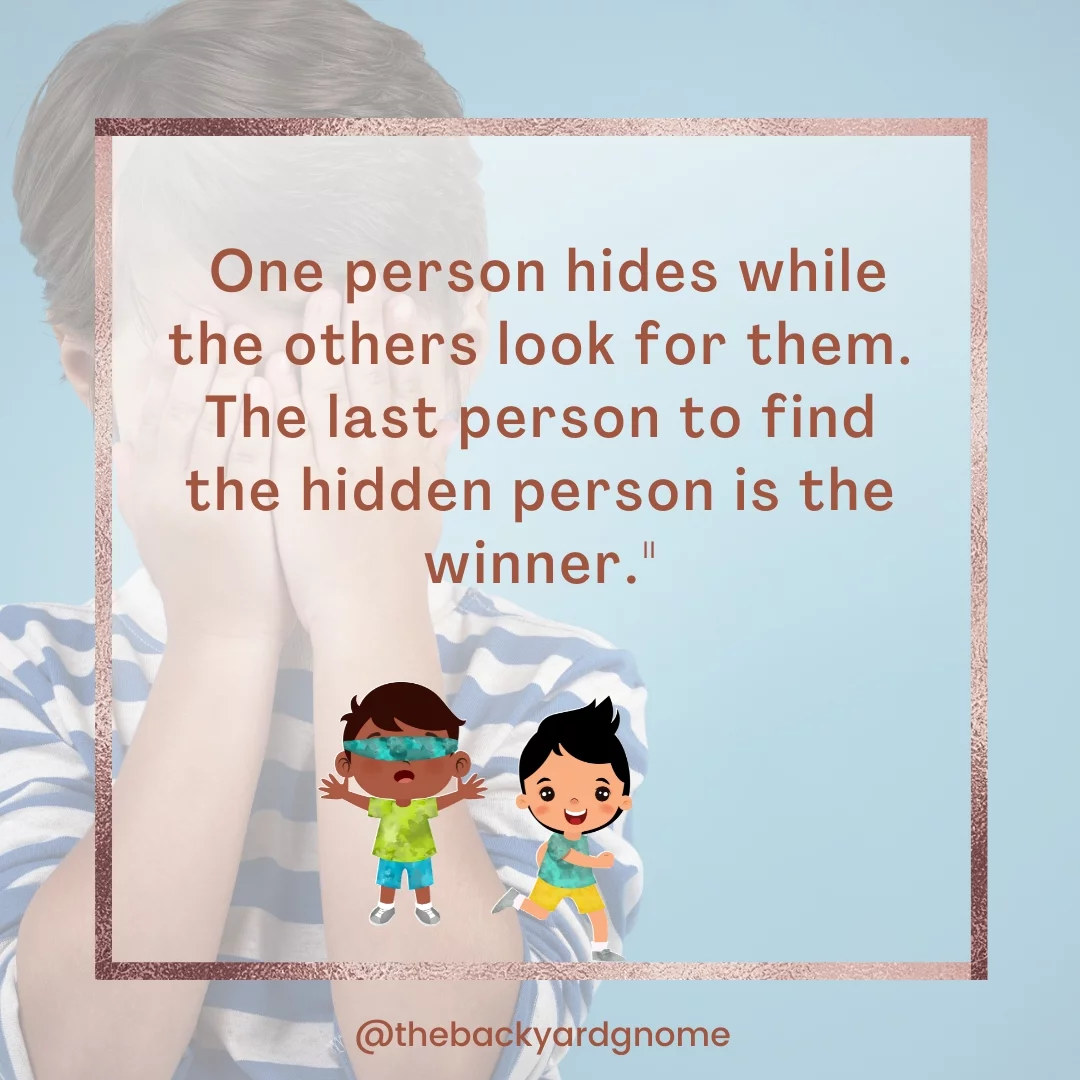
4. One person hides while the others look for them. The first person to find the hidden person gets a point, and the game continues until someone has collected a certain number of points (usually 3 or 5).
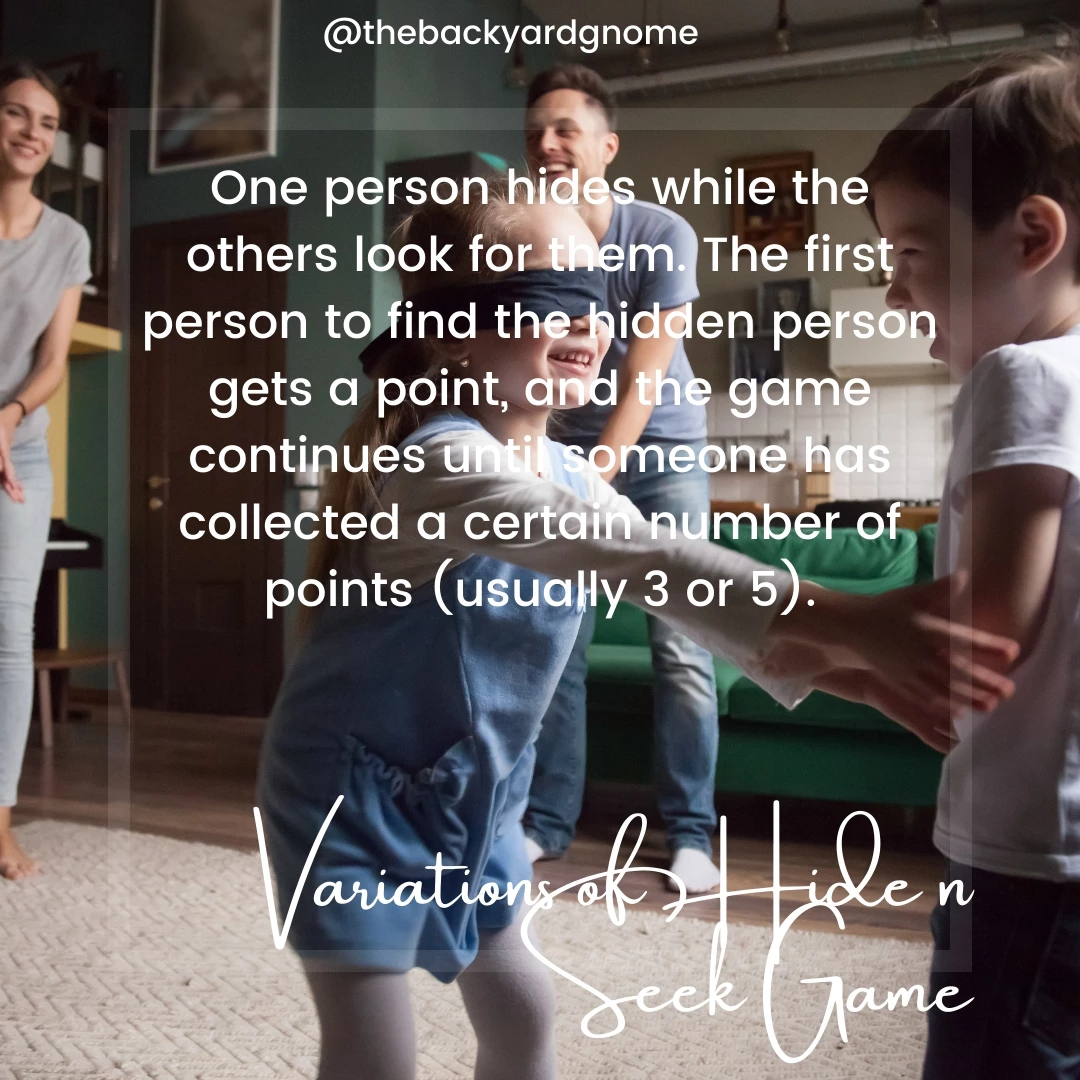
5. All of the people hide at once, and then one person tries to find everyone else. The first person to find everyone else is the winner.
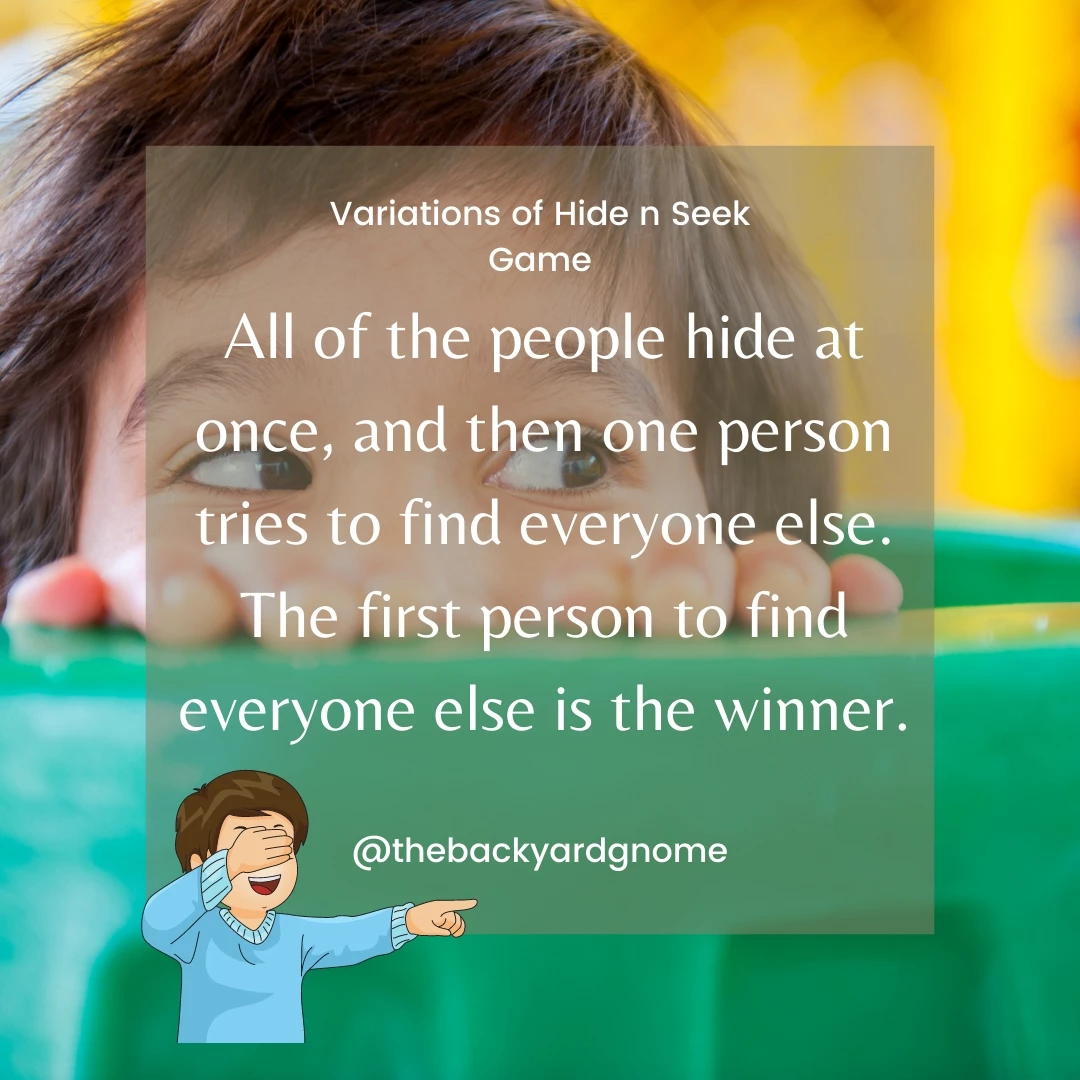
6. All of the people hide at once, and then one person tries to find everyone else. The first person to find everyone else gets a point, and the game continues until someone has collected a certain number of points (usually 3 or 5).
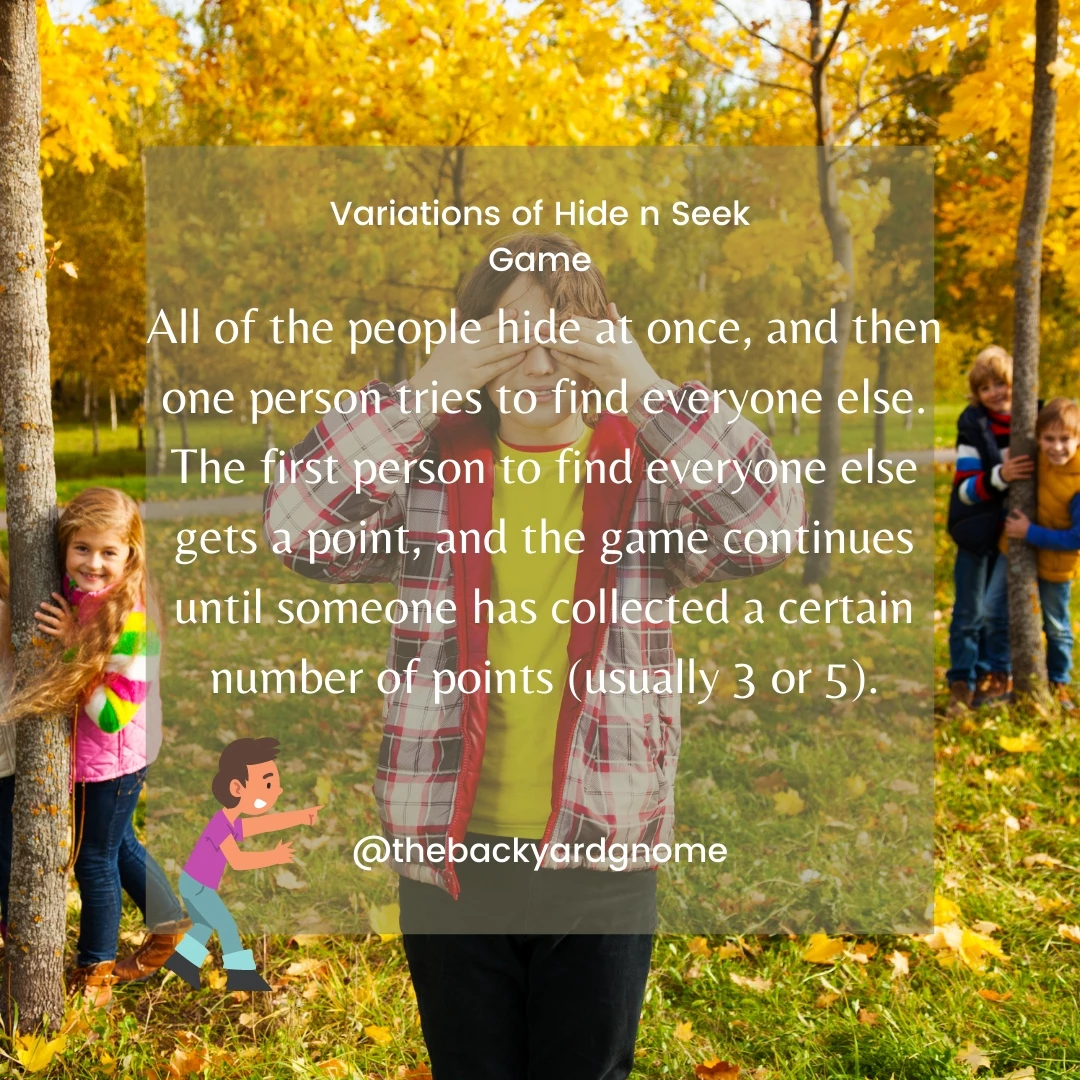
7. All of the people hide at once, and then one person tries to find everyone else. The last person to be found is the winner.
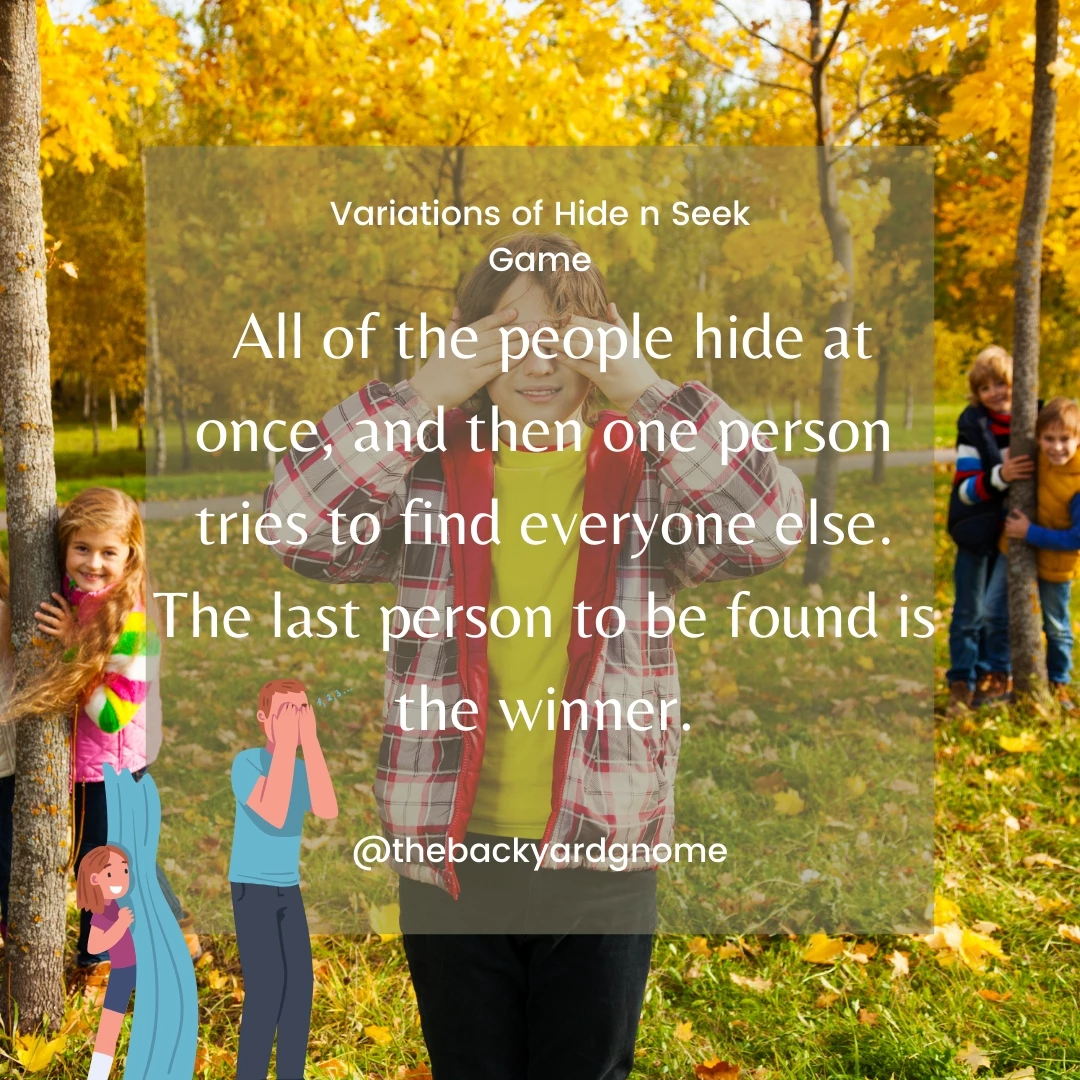
8. One person hides while the others look for them. The hidden person can move around while the others are looking for them, and the first person to find them gets a point. The game is over when someone has collected a certain number of points (usually 3 or 5).
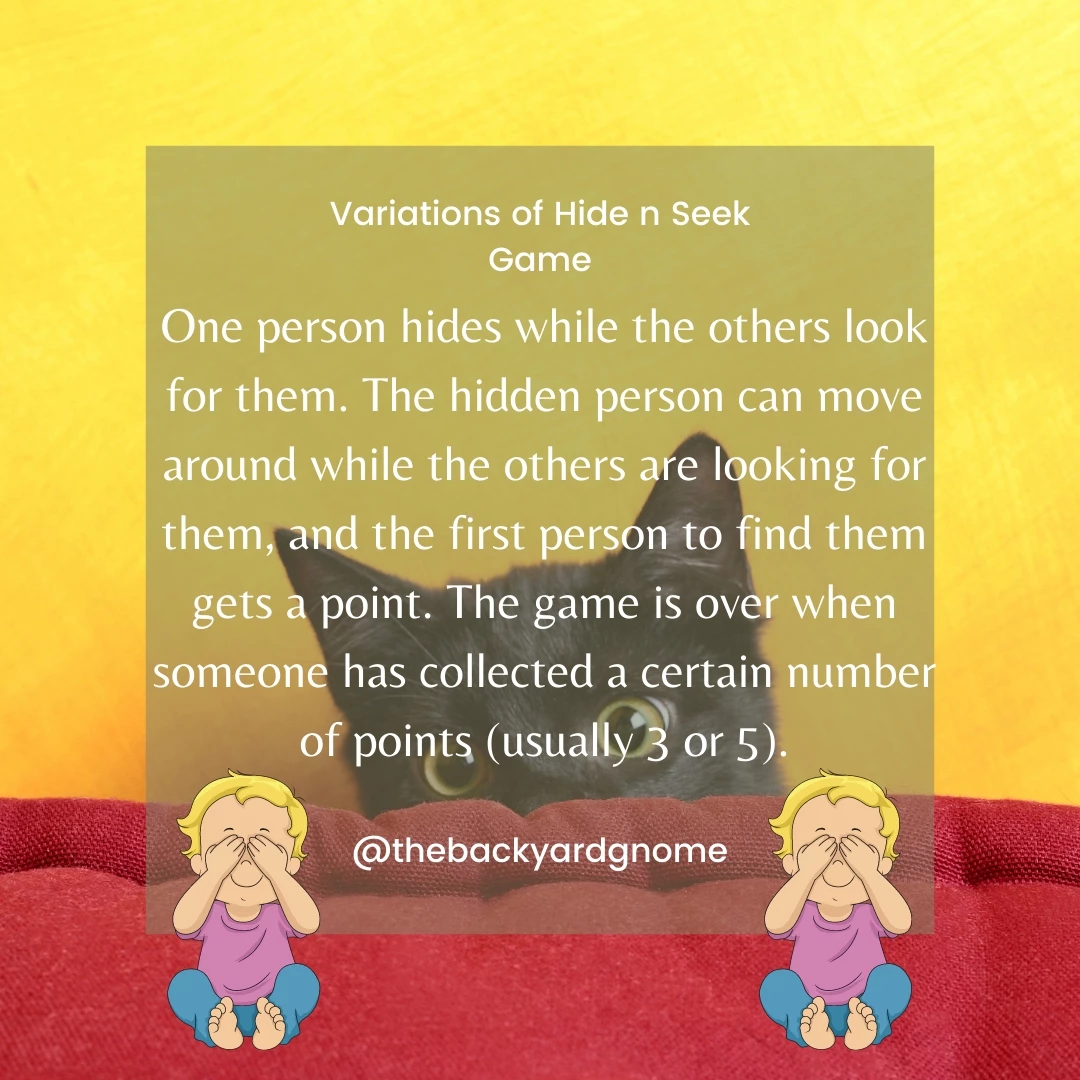
9. One person hides while the others look for them. The hidden person can move around while the others are looking for them, and the last person to find them is the winner.
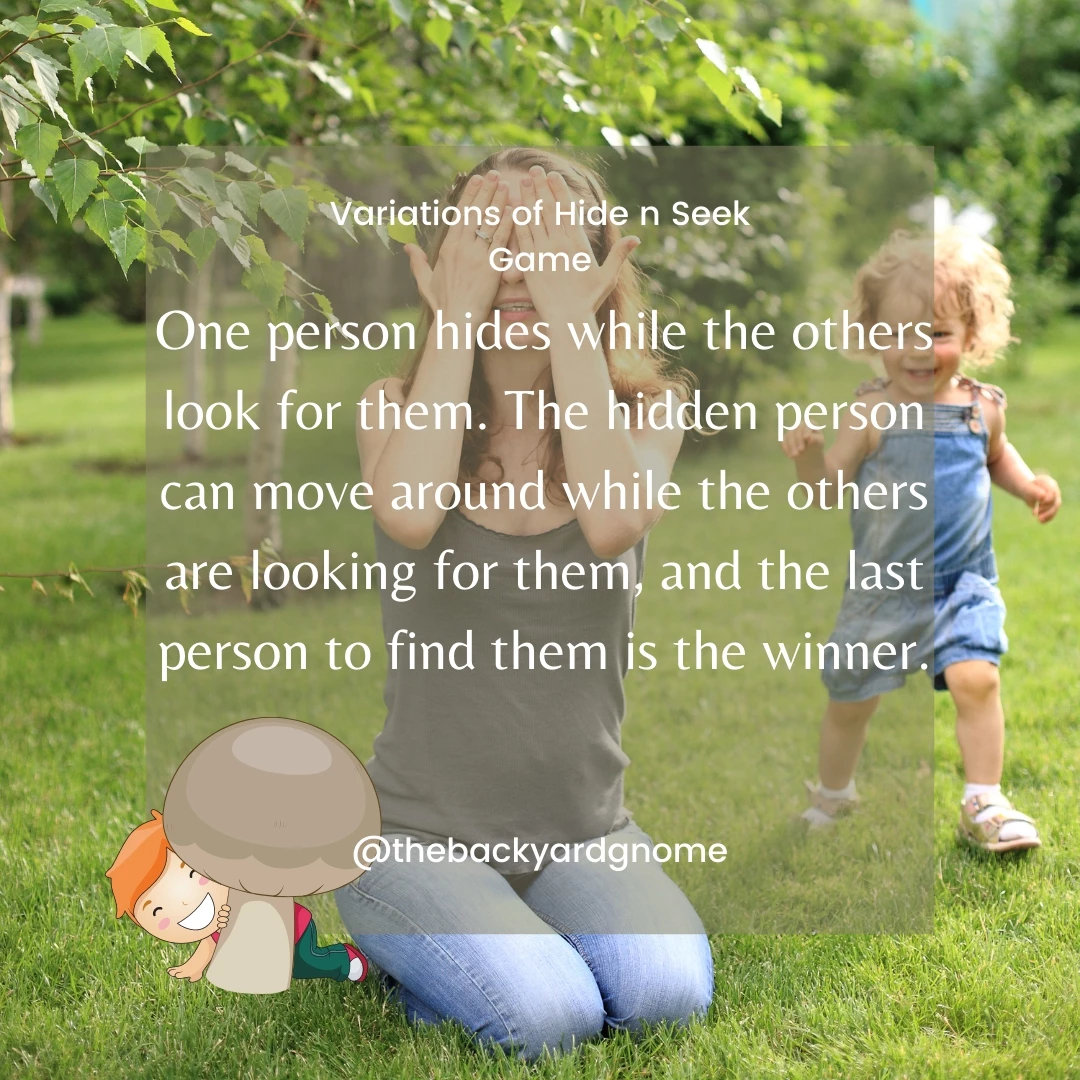
10. One person hides while the others look for them. The first person to find the hidden person gets a point, but if the hidden person is found by someone other than the seeker, that person gets a point as well. The game is over when someone has collected a certain number of points (usually 3 or 5).
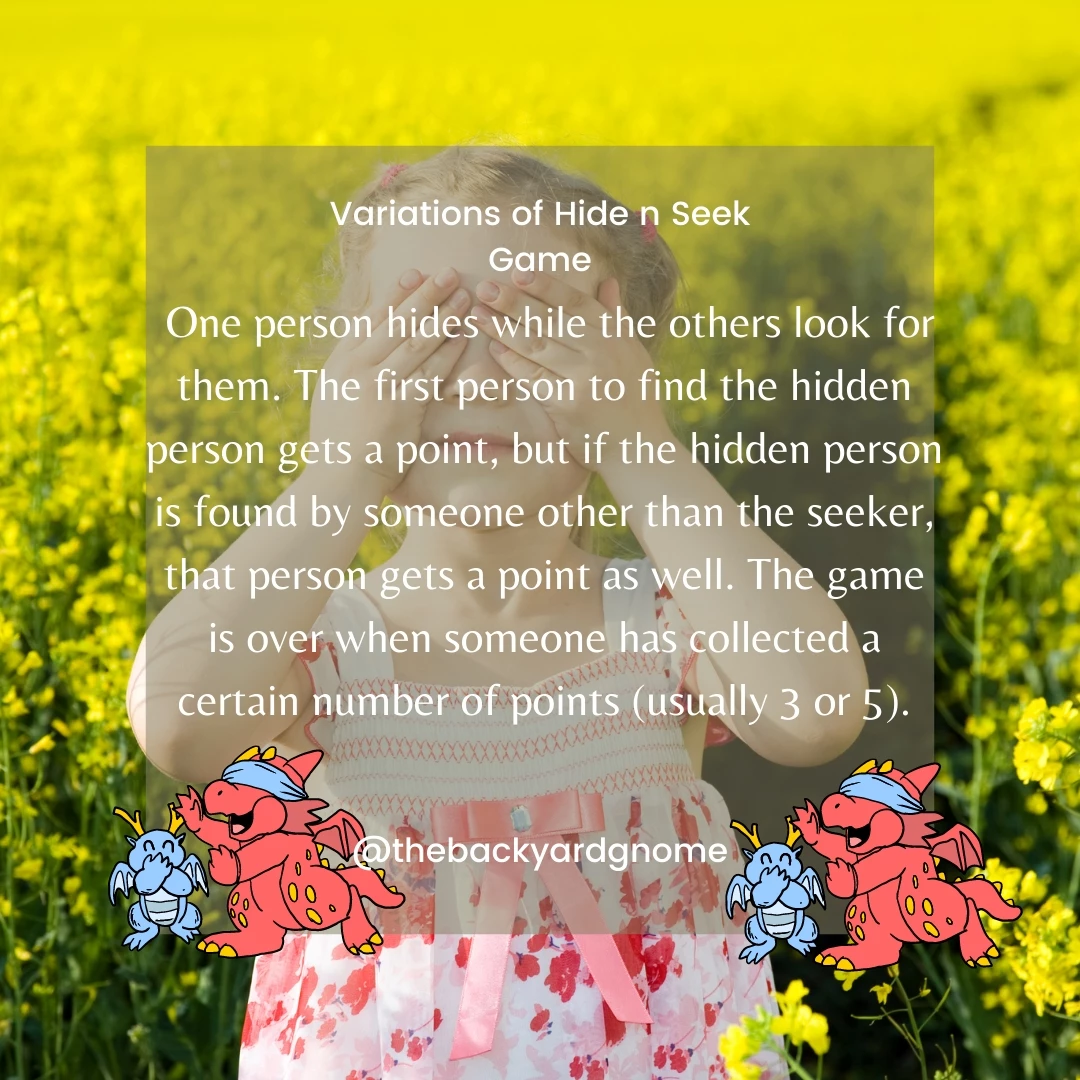
11. All of the people hide at once, and then one person tries to find everyone else. The person who finds the most people is the winner.
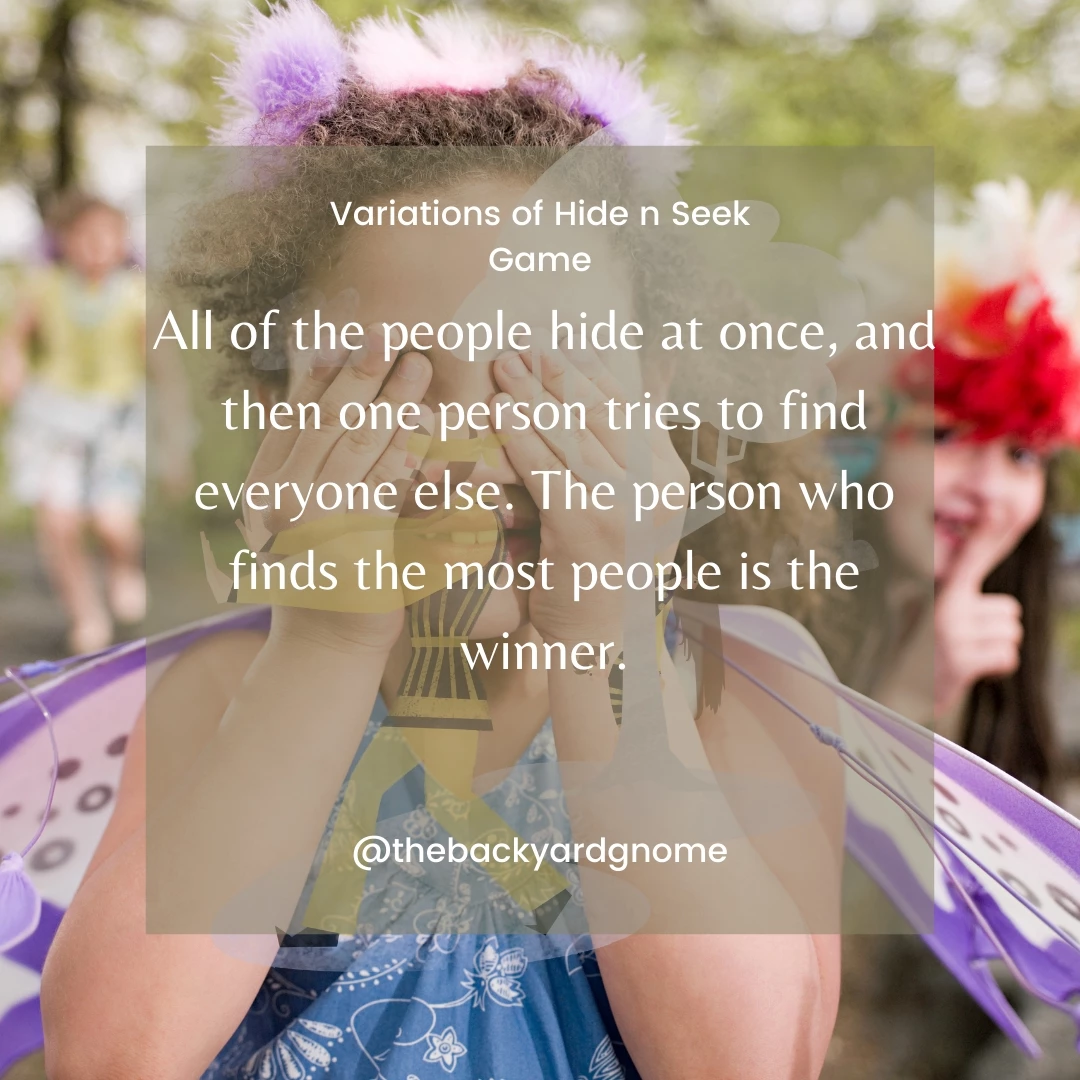
12. All of the people hide at once, and then one person tries to find everyone else. The person who finds the fewest people is the winner.
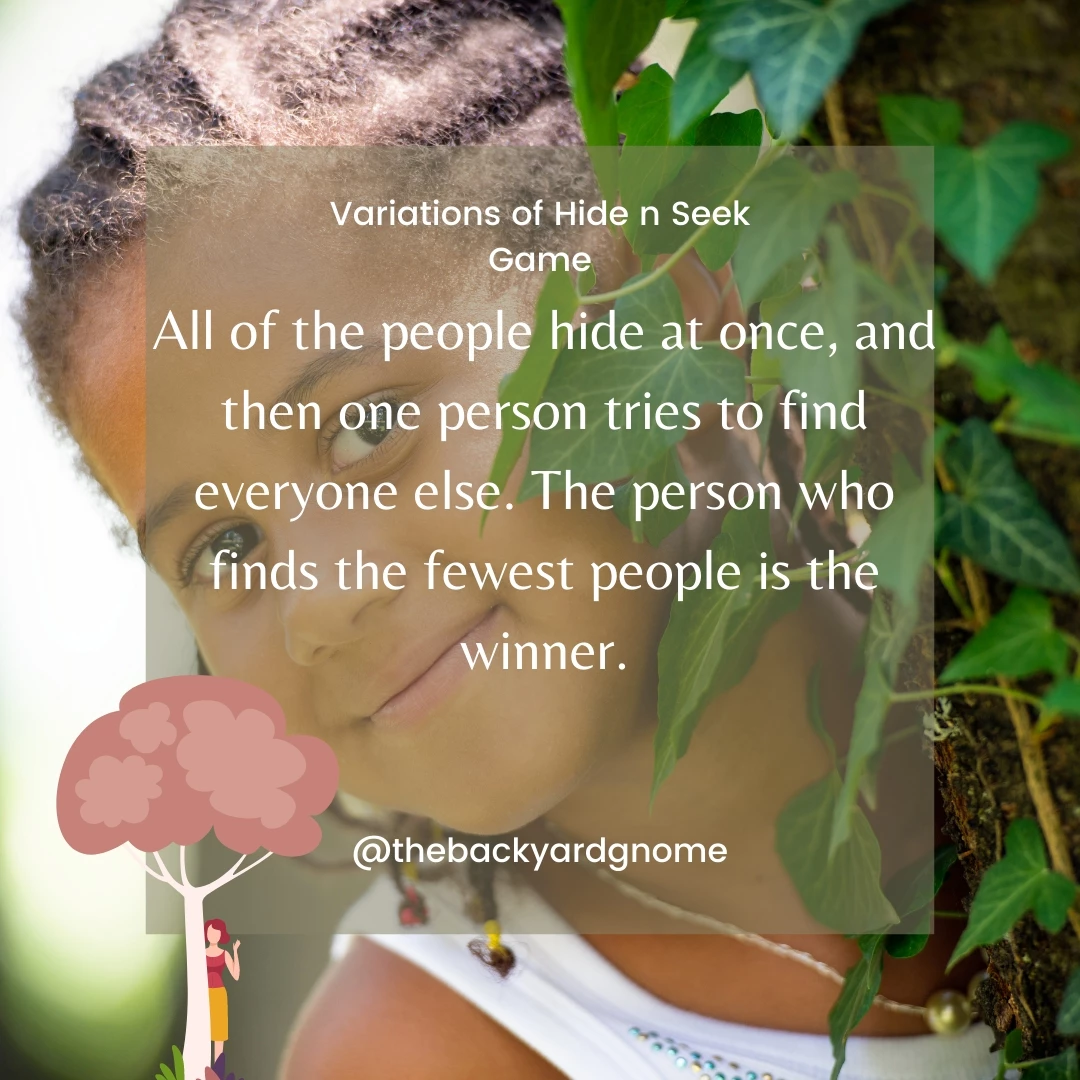
13. One person hides while the others look for them. The first person to find the hidden person gets a point, but if the hidden person is found by someone other than the seeker, that person gets two points. The game is over when someone has collected a certain number of points (usually 3 or 5).
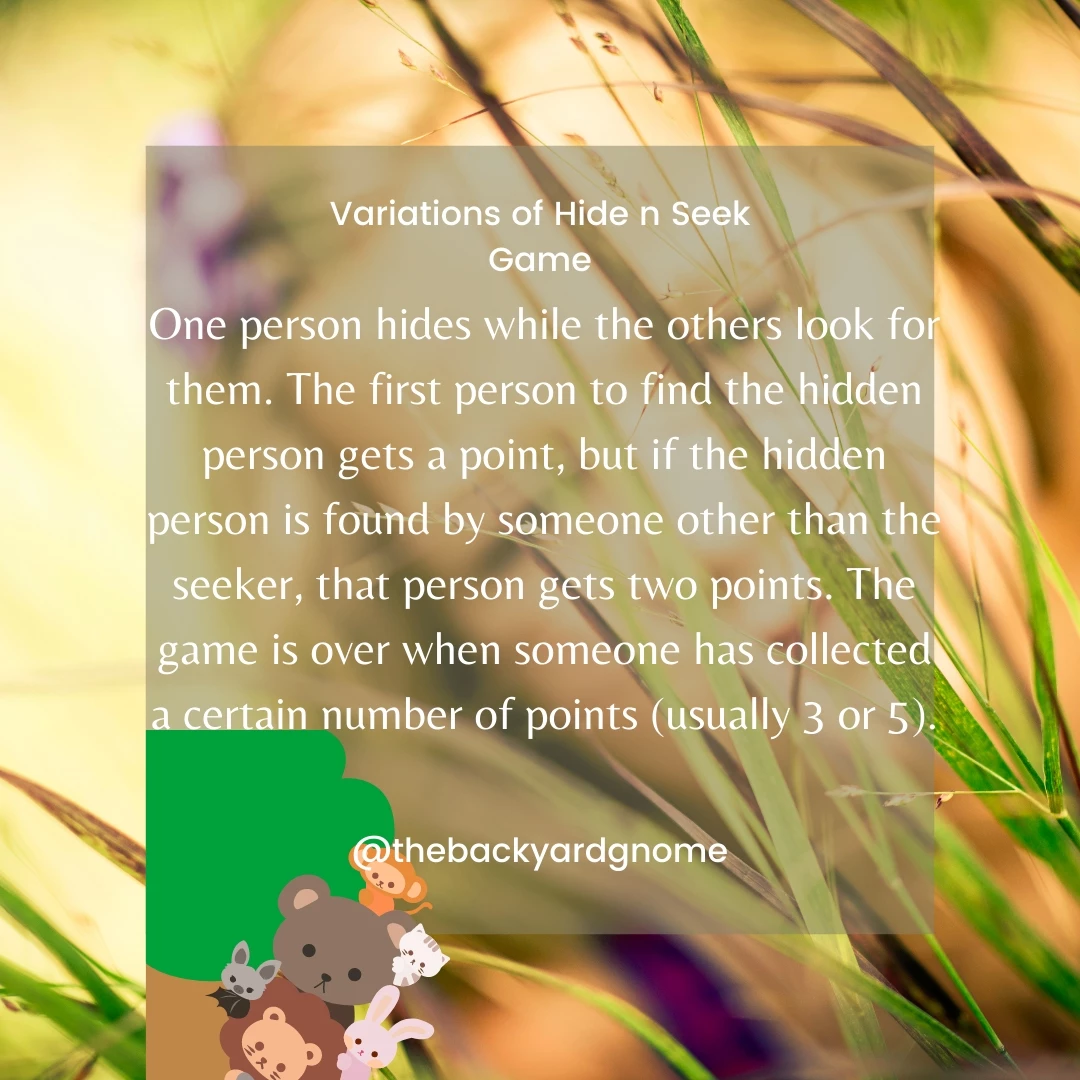
14. One person hides while the others look for them. The first person to find the hidden person gets a point, and the game continues until someone has collected a certain number of points (usually 3 or 5). However, if the hidden person is found by someone other than the seeker, that person gets two points and the game ends immediately.
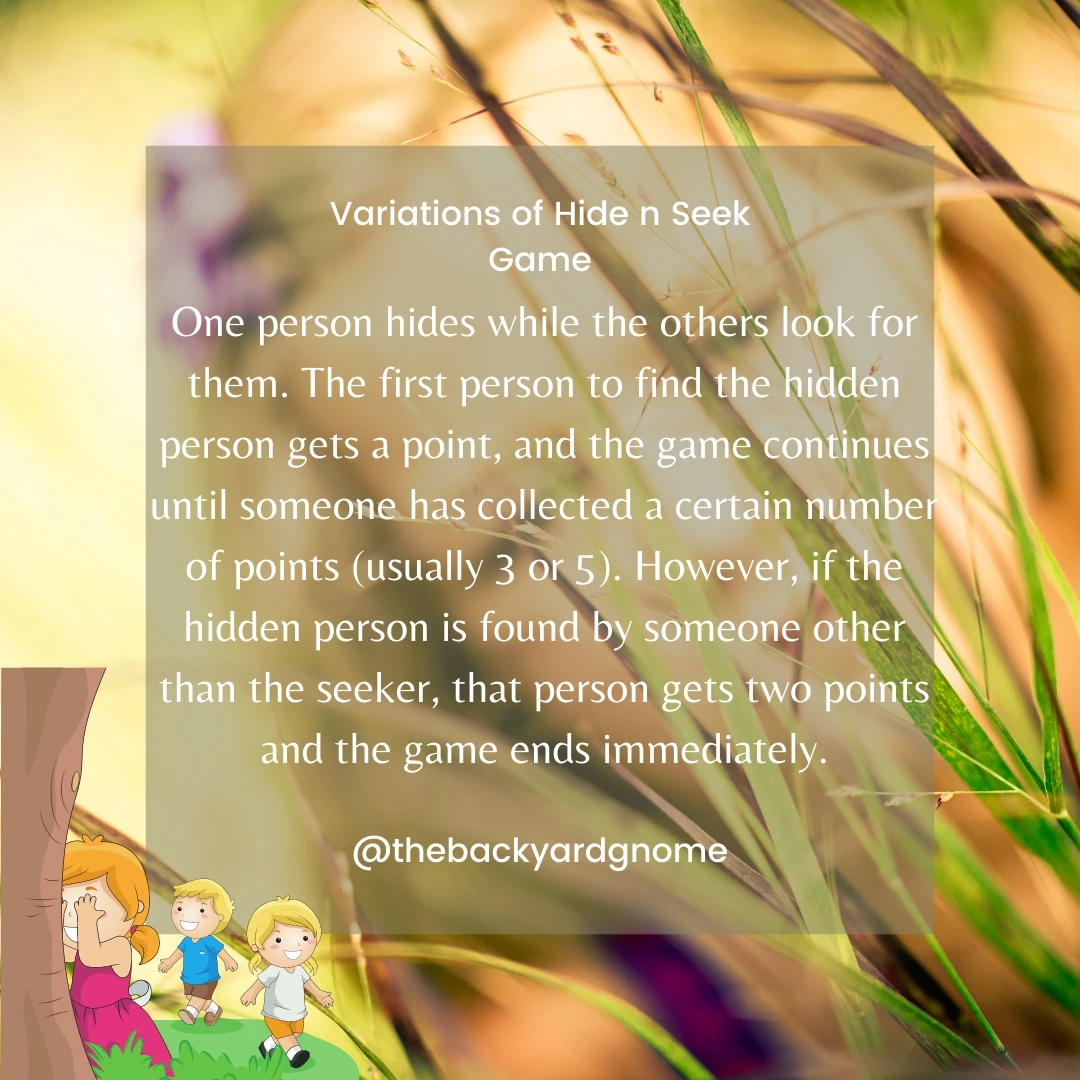
15. One person hides while the others look for them. The first person to find the hidden person wins, but if the hidden person is found by someone other than the seeker, that person gets to be the next hider.
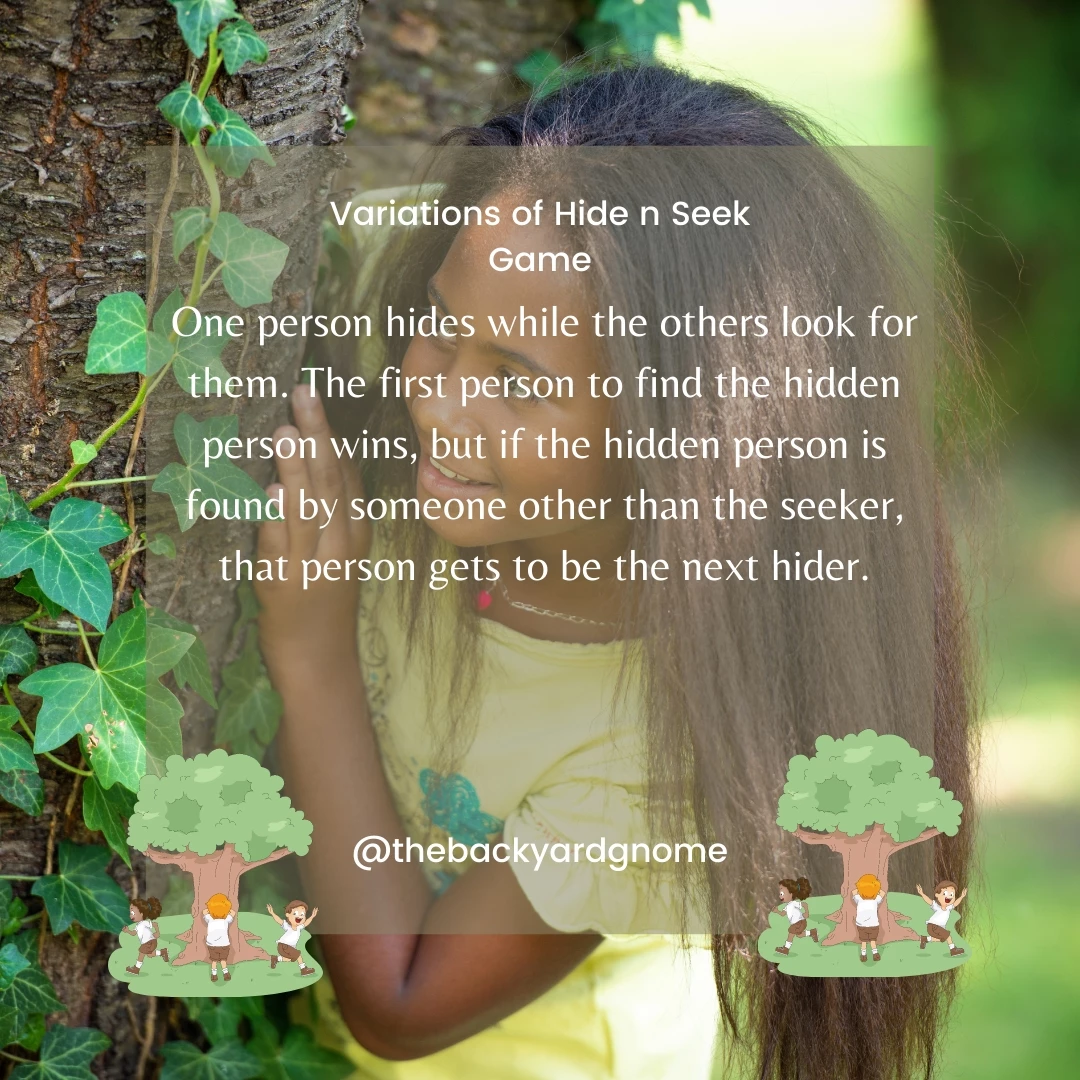
16. All of the people hide at once, and then one person tries to find everyone else. The first person to find everyone else gets a point, but if they are found by someone other than the seeker, that person gets two points. The game is over when someone has collected a certain number of points (usually 3 or 5).
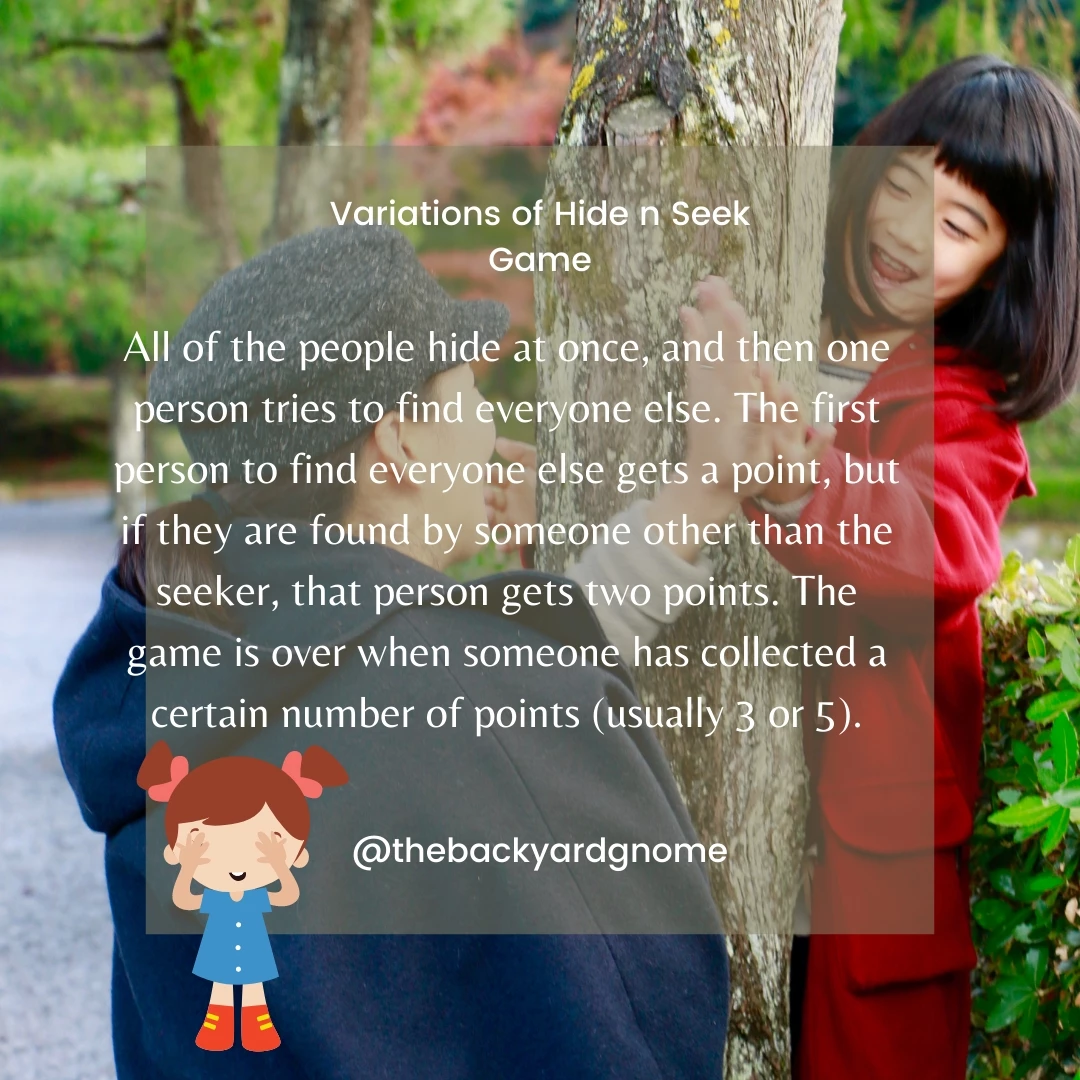
17. All of the people hide at once, and then one person tries to find everyone else. The first person to find everyone else gets a point, and the last person to be found gets a point as well. The game is over when someone has collected a certain number of points (usually 3 or 5).
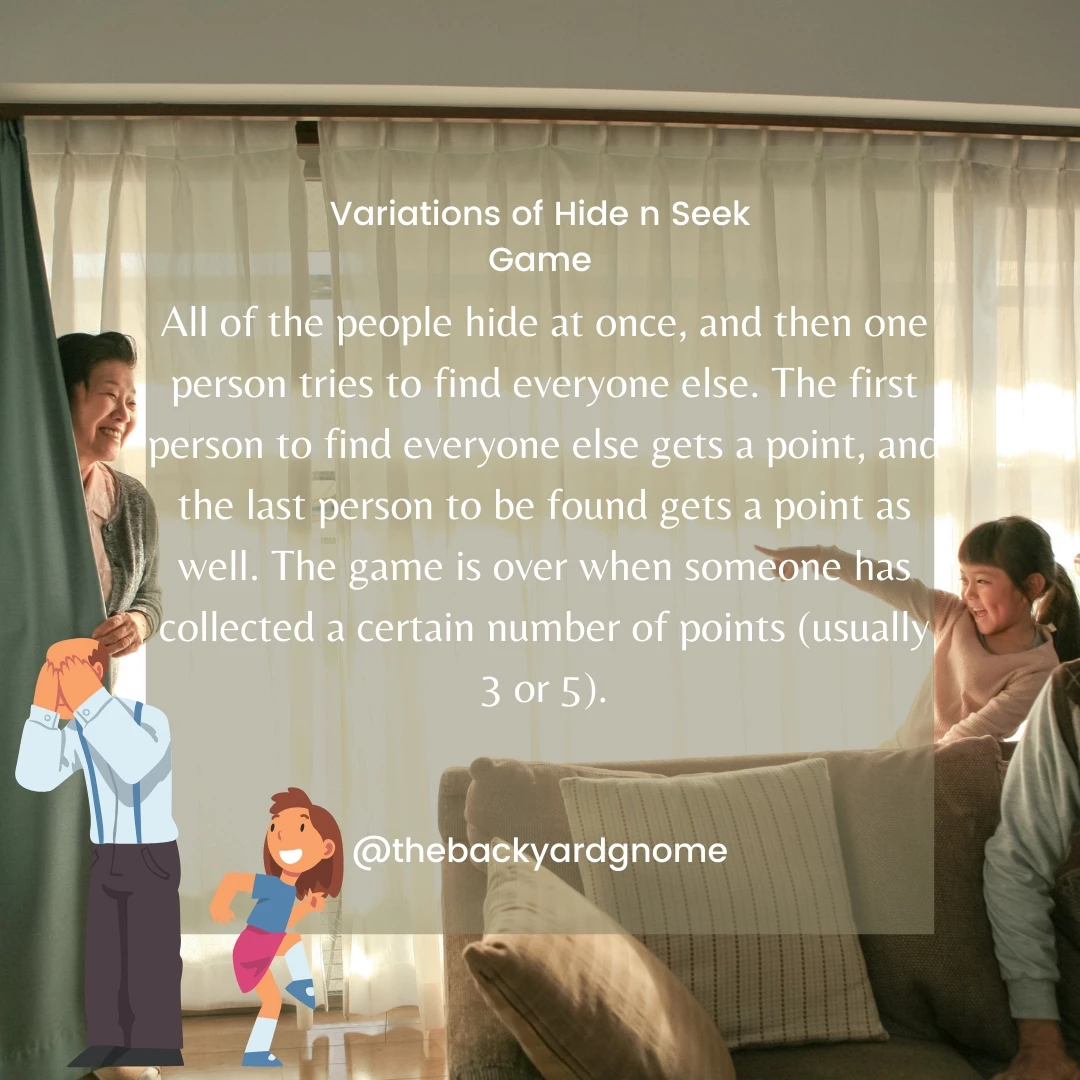
18. One person hides while the others look for them. The hidden person can move around while the others are looking for them, and the first person to find them gets a point. However, if the hidden person is found by someone other than the seeker, that person gets two points. The game is over when someone has collected a certain number of points (usually 3 or 5).

19. One person hides while the others look for them. The hidden person can move around while the others are looking for them, and the last person to find them gets a point. However, if the hidden person is found by someone other than the seeker, that person gets two points and the game ends immediately.
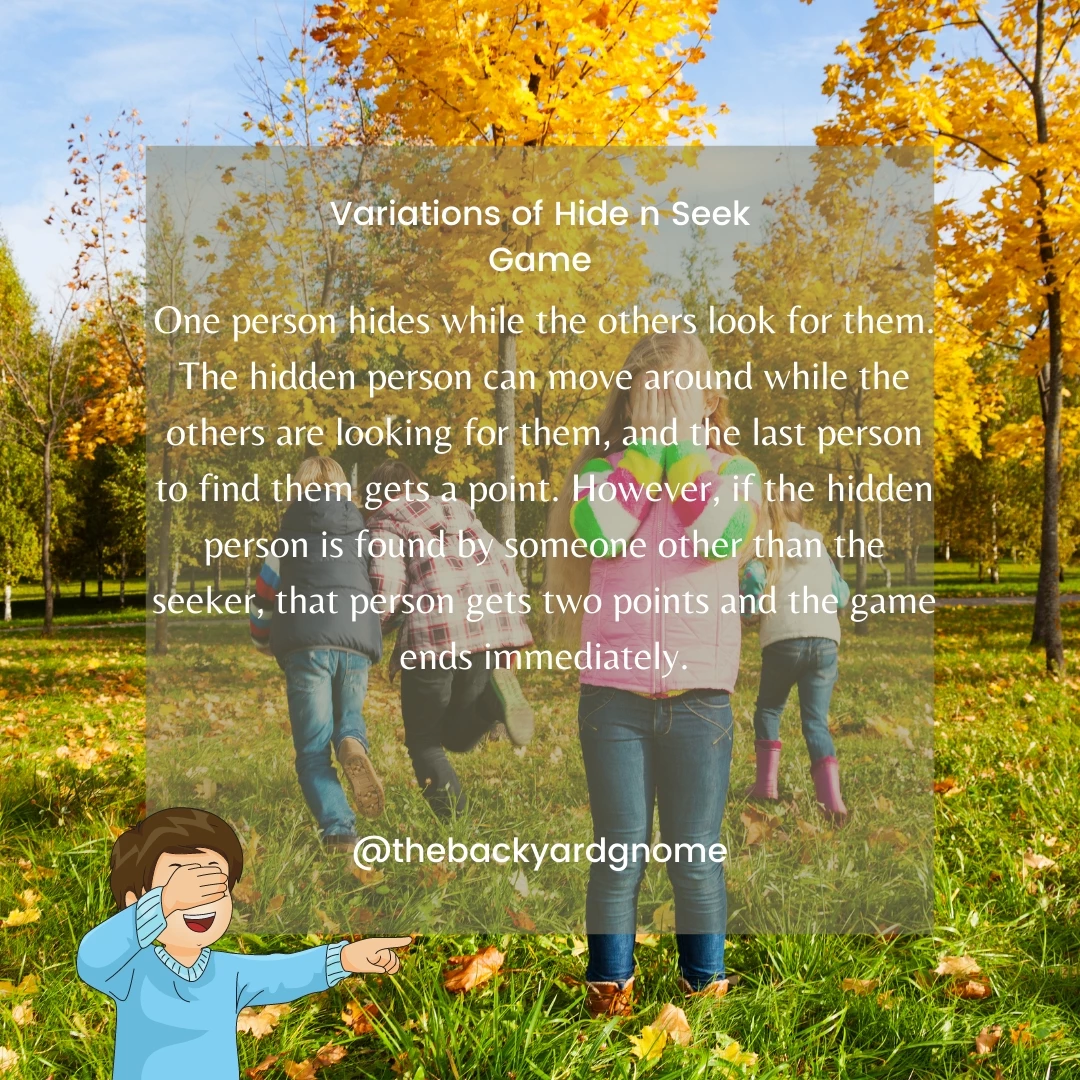
20. One person hides while the others look for them. The first person to find the hidden person gets a point, but if the hidden person is found by someone other than the seeker, that person gets two points and the game ends immediately. If no one finds the hidden person within a certain time limit, then the hider wins.
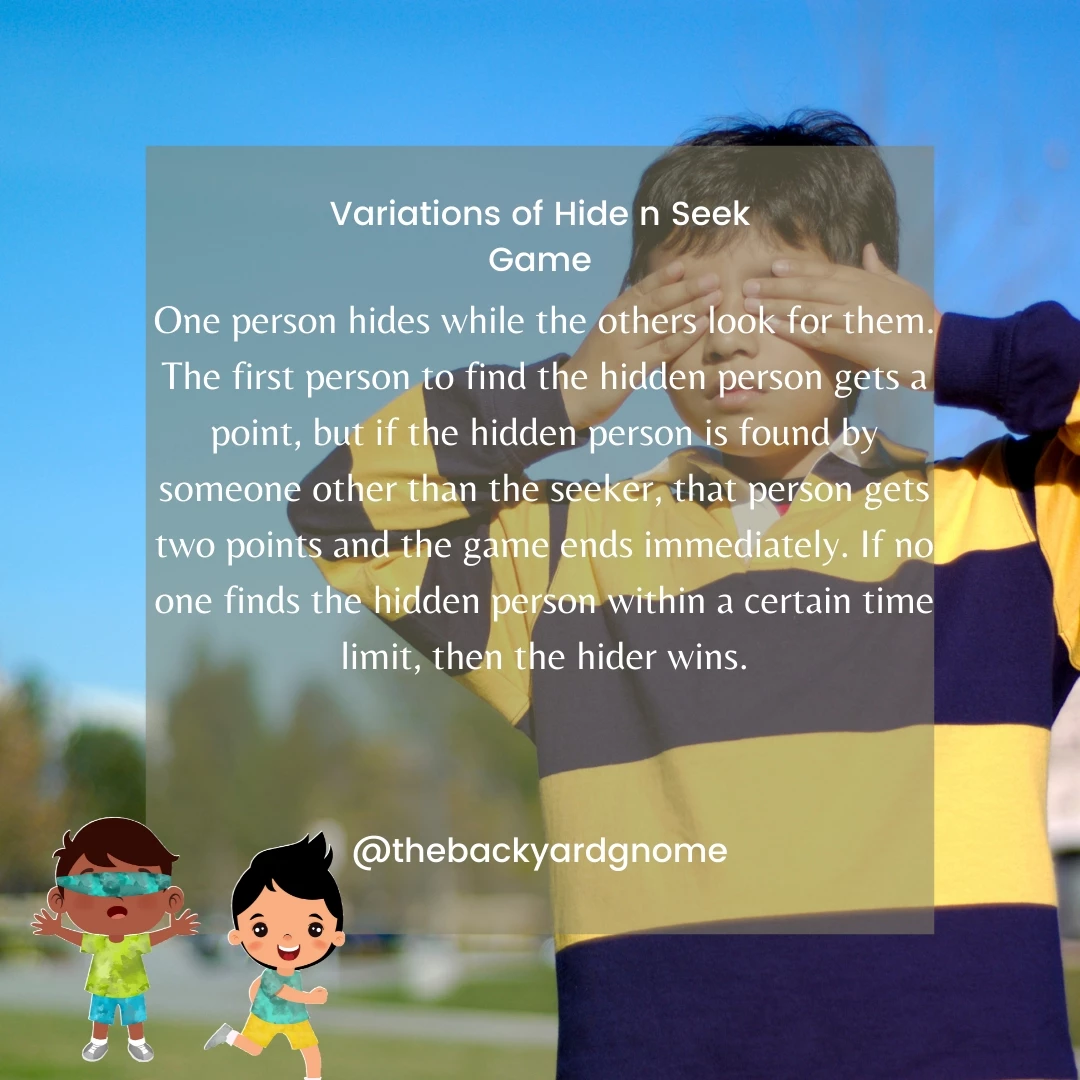
21. One person hides while the others look for them. The hidden person can move around while the others are looking for them, and the first person to find them gets a point. However, if the hidden person is found by someone other than the seeker, that person gets two points and the game ends immediately. If no one finds the hidden person within a certain time limit, then the hider wins.
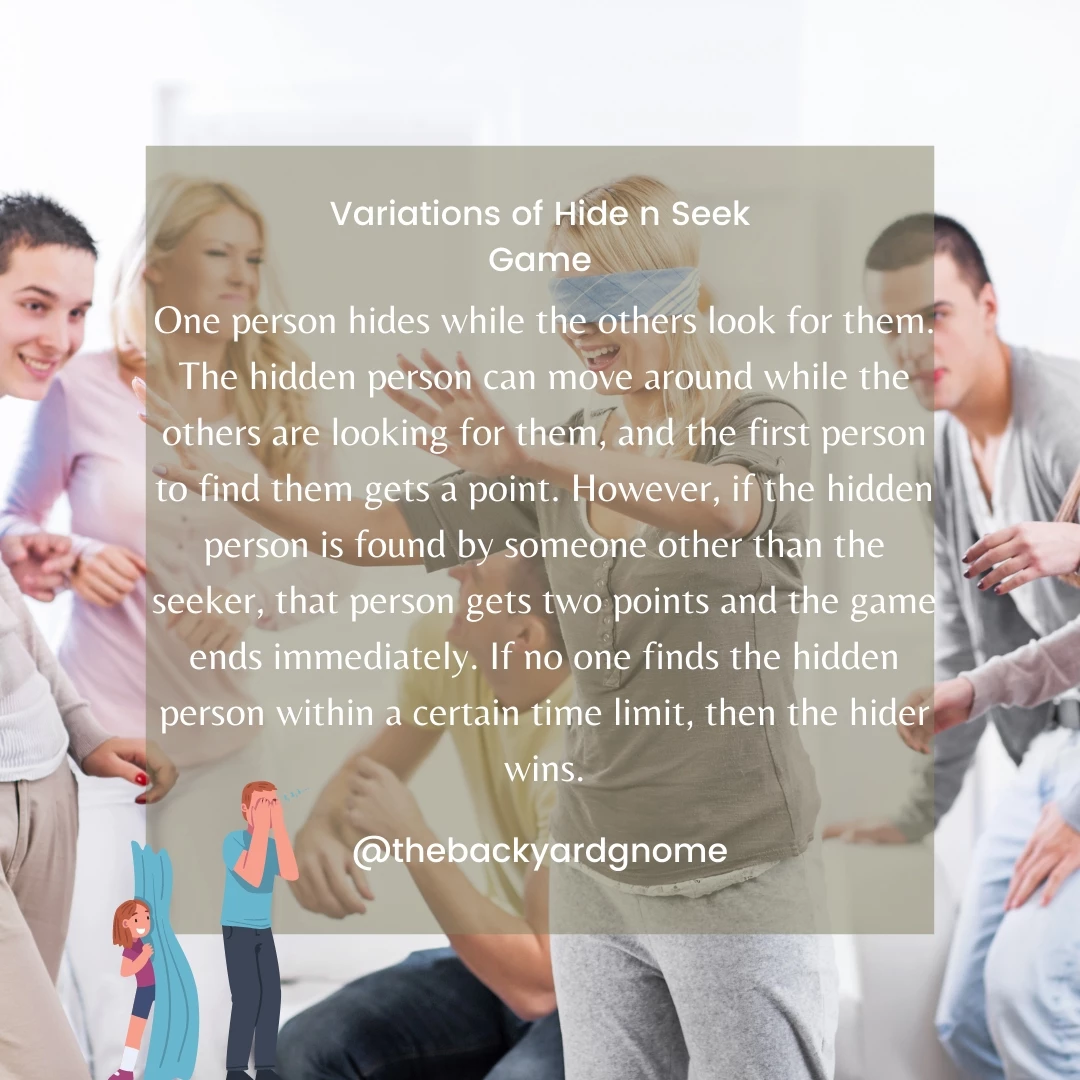
22. All of the people hide at once, and then one person tries to find everyone else. The first person to find everyone else gets a point, but if they are found by someone other than the seeker, that person gets two points and the game ends immediately. If no one finds everyone else within a certain time limit, then the person who is hidden the longest wins.
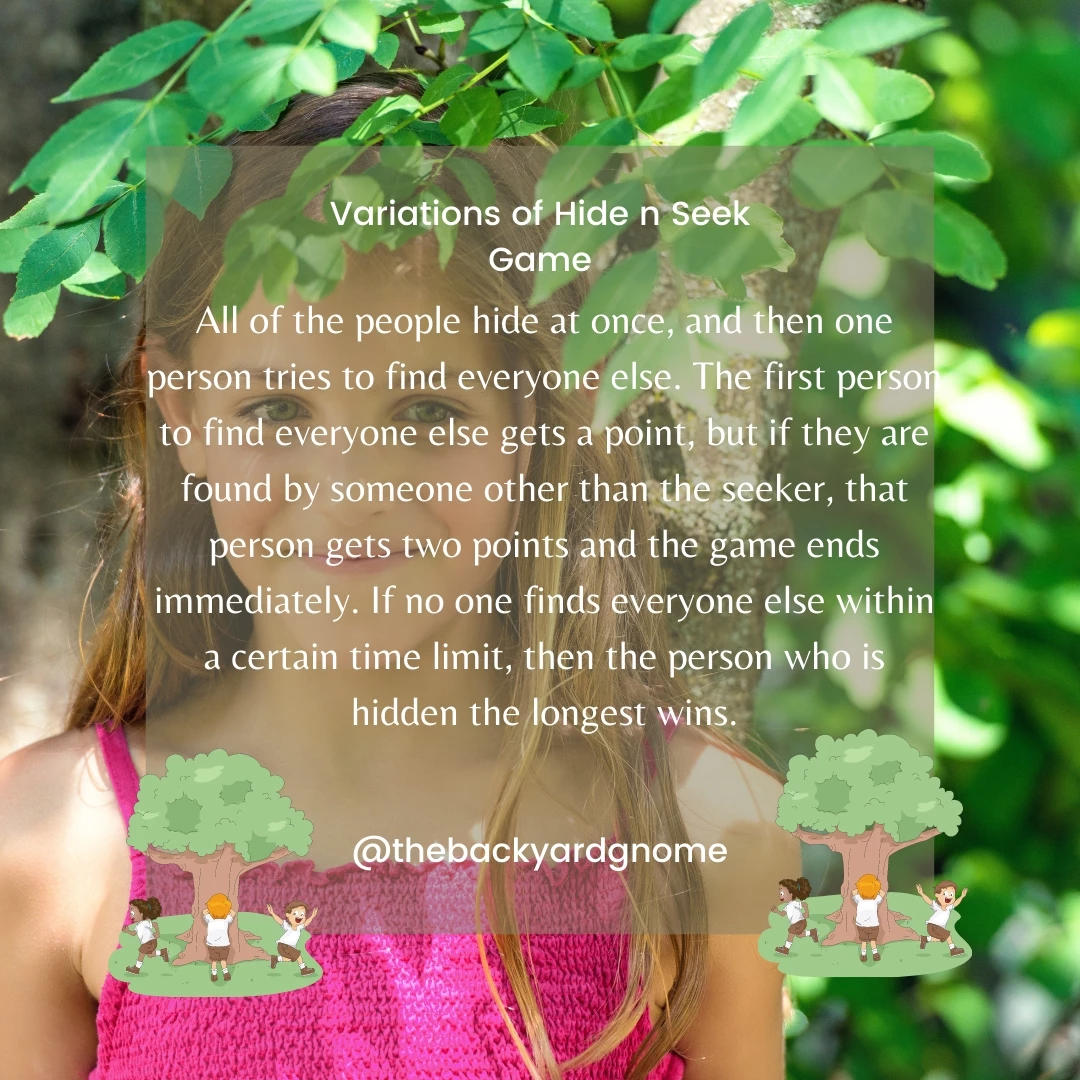
23. All of the people hide at once, and then one person tries to find everyone else. The first person to find everyone else gets a point for each person they find, but if they are found by someone other than the seeker, that person gets two points for each person they find and the game ends immediately. If no one finds everyone else within a certain time limit, then the person who is hidden the longest wins.
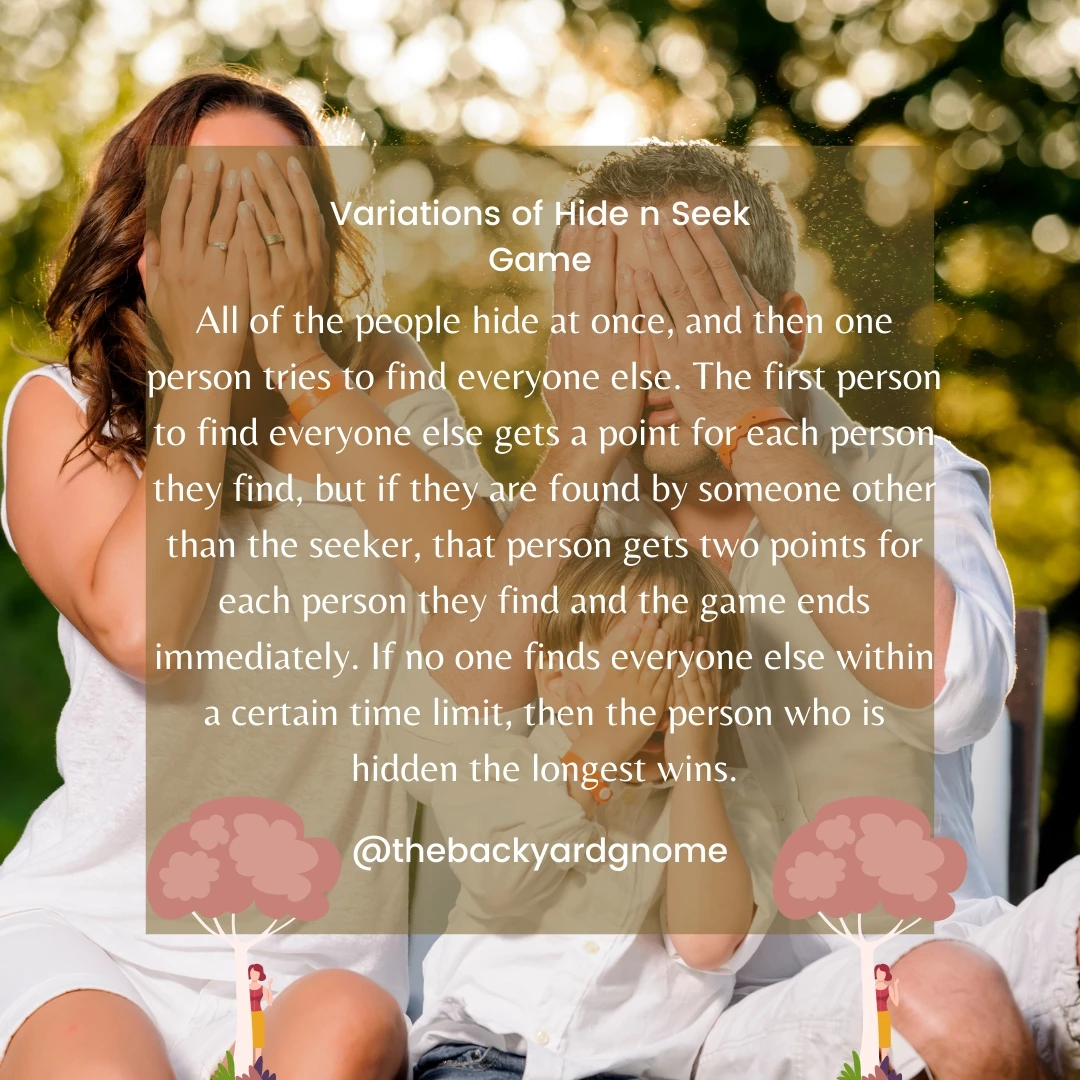
Olly Olly Oxen Free

Olly olly oxen free is a phrase typically used in these games where the seeker yells out, "Olly olly oxen free!" to let the remaining hidden players they can come out or back to the home base without being caught; they are free and won't be tagged.
Olly olly oxen free,
All come out to play.
The moon shines bright as day,
So come on out to play.

Olly Olly Oxen Free is a children's game that can be enjoyed by all ages. It is played by two or more people and involves hiding objects around the playing area, then finding them again. The game is thought to originate from England, and its name may come from the phrase "all together now."
There are no specific rules to the game, but it is usually played with a few basic guidelines in mind. For example, players typically take turns hiding and finding objects, and the first person to find all of the hidden objects is declared the winner.
Olly Olly Oxen Free can be played indoors or outdoors, making it a great option for rainy day fun or a backyard party game. It's also a great way to get kids moving and using their imaginations. So break out the hidden objects and let the fun begin!
Sardines
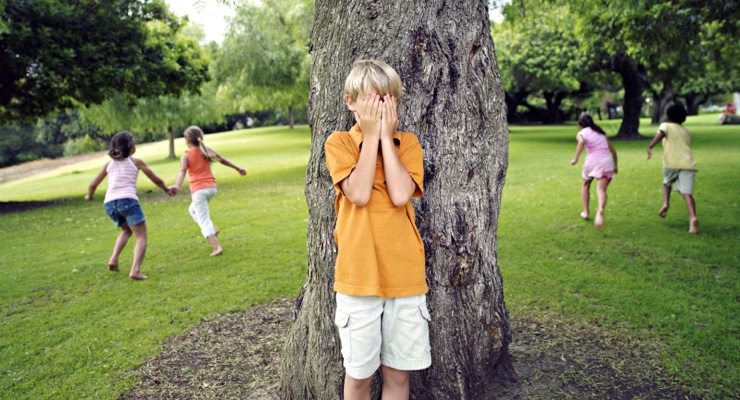
Sardines is like hide and seek but rather the opposite: one player hides while the others try to find them. When one player finds the hidden person, they join them in hiding. Each player who finds the hidden players joins them, until they look like packed sardines in a tin box.
Ghost in the Graveyard
Ghost in the Graveyard is another variation of hide and seek that is played at night in the dark. It employs three or more players in an outdoor area. The ghost is the person hiding, and the other players try to find them. The player who finds the ghost yells "ghost in the graveyard!"
Related posts:
- How To Roll The Hugest Snowball Possible - Your Essential Guide
- How To Make DIY Glitter-Dipped Balloons
 |
 |
 |
 |

About Simmy Parker
Simmy is an outdoor expert who loves to spend time in the wilderness. She received a BS degree in Civil Engineering at Sacramento State University, and has put her skills to use by helping design and build some of the most impressive structures in the world. However, Simmy's true passion lies in sharing her love of nature with others, and she spends much of her free time leading hikes and teaching people about the flora and fauna that can be found all around them.
Thoughts on "Hide and Seek (Rules and History)"
 |
 |
 |
 |
You can Get FREE Gifts. Receive Free Backyard Items here. Disable Ad Blocker to get them all now!
Once done, hit anything below
 |
 |
 |
 |